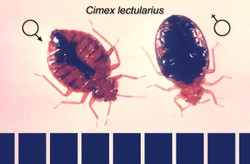Naturally, one must also be certain that bedbugs are the problem, and there are clinical signs and symptoms that will help to answer this question. For example, bites from these arthropods will lead to pink skin lesions which are non-raised and which subsequently progress to raised or papular [1, 2, 3].
There may be itching as well as vasculitis and the appearance of bullae and necrotic plaques. The patient will have a generally poor feeling, and fever may occur. The physician has to consider other well-known dermatologic possibilities such as allergic reaction to food or medication. In addition, scabies, chicken pox, and dermatitis herpetiformis will be on the list of differential diagnoses [1, 2].
Clinicians have also observed that skin lesions from bedbug bites sometimes occur in groups of three, and the name for this is “breakfast, lunch, and dinner” sign.
Though scabies and bedbugs may respond to similar pesticides, there are variations in the skin of these two infestations. For example, scabies leaves burrows in the person’s skin. Bedbugs, on the other hand, tend to leave marks on parts of the human body where clothing does not cover the skin. They may also bite the eyelid of the individual as well as the armpit or waist
[1, 2, 3].
Another clue to identify bedbugs is the presence of reddish-brown specks of heme or feces on bed linens. Of course, one can also observe the insects crawling around the house, but the best way to confirm the diagnosis is through capture of the arthropods and delivery to a health care facility. The laboratory staff will be able to examine them and identify what they really are
[1, 2, 3].
Life-threatening anaphylaxis is not common with these situations; however, it is still a consideration. Attacks from bedbugs can also lead to anemia and exacerbation of mental illness. Should an allergic reaction take place in these clients, the use of topical corticosteroids and antihistamines is beneficial [1].
In the rare instances of anaphylaxis, one must execute aggressive management with injectable epinephrine and antihistamines as well as corticosteroids via parenteral administration. They will also require oxygen supplementation and bronchodilators as well as any other emergency measures necessary.




 The Reality of Aspirinon 05/24/2021
The Reality of Aspirinon 05/24/2021
 An Old Microbeon 03/31/2021
An Old Microbeon 03/31/2021
 Coronavirus and Mental Illnesson 02/14/2021
Coronavirus and Mental Illnesson 02/14/2021
 Acute Ischemic Strokeon 12/25/2020
Acute Ischemic Strokeon 12/25/2020


Comments